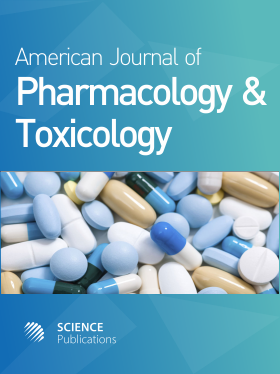Taurine Implicated in Bromocriptine Induced Hallucination: Glycine-Glutamic-Aspartic Implicated in Bromocriptine Induced Schizophrenia
- 1 Ajman University of Science and Technology, United Arab Emirates
Abstract
Problem statement: The literature is reviewed and supports a strong anecdotal relationship between bromocriptine use and psychosis. It is well known that any interference with brain amino acid levels is likely to lead to disorder. Our previous research has shown that bromocriptine produced significant changes in the heart and kidneys amino acid contents. It has been confirmed that the brain amino acids concentrations are influenced by plasma amino acid levels. Therefore, it is the thought of interest to investigate the effect of bromocriptine, sulpiride or their combination on the brain and plasma amino acid concentrations of rat. Approach: The influence of chronic treatment with bromocriptine 20 mg kg day-1 i.p, sulpiride 20 mg kg day-1 i.p. or their combination bromocriptine 20 mg kg day-1 i.p + sulpiride 20 mg kg day-1 i.p. for 6 weeks on free amino acids in the brain and the plasma of rats were carried out. The amino acids were quantified using the LKB 4400 Amino Acid Analyzer and the Hami1ton’s amino acid calibration standards. Results: Bromocriptine significantly decreased the plasma content of glutamic acid, glycine and alanine. (p<0.05, n = 7). Sulpiride did not affect basal or bromocriptine-induced changes in the plasma amino acid concentrations. Also, results indicate that bromocriptine decreased the brain content of taurine, glycine and aspartic acid. The mean % decreases were 40±3, 55±6 and 30±4 respectively (p<0.01, n = 7). Sulpiride prevented the decreases in glycine and aspartic acid only. Conclusion: This study provided evidence for the possible involvement of some amino acids in mediating some actions of bromocriptine. Our previous results presented evidence for the antagonistic effect of taurine on some bromocriptine-induced actions that probably involve activation of 5-HT receptors. As a result, bromocriptine-induced depletion of brain taurine, which involved activation seretonergic receptors, may underlie the appearance of some side effects of bromocriptine such as hallucinations in Parkinson’s patients. Thus, bromocriptine induced hallucination is related to non dopaminergic action. Further, the results direct the attention to the possible involvement of glycine, aspartic and glutamic in bromocriptine induced schizophrenia. This study indicates that different mechanisms of the etiology of schizophrenia which are not possible based upon dopaminergic mechanism alone.
DOI: https://doi.org/10.3844/ajptsp.2010.34.41

- 6,419 Views
- 4,984 Downloads
- 1 Citations
Download
Keywords
- Bromocriptine
- sulpiride
- amino acids
- brain
- plasma
- taurine
- hallucinations
- glycine
- glutamate
- aspartic
- schizophrenia
